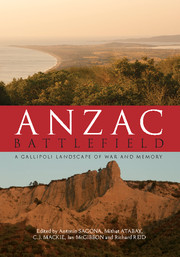Book contents
- Frontmatter
- Foreword
- Contents
- Figures
- Plates
- Contributors
- Acknowledgements
- Abbreviations
- Gallipoli battlefield place names
- Introduction
- 1 Boundary and divide: The antiquity of the Dardanelles
- 2 The Gallipoli campaign: History and legend
- 3 Recording the battlefield: First steps
- 4 Capturing the battlefield: Mapping and air photography at Gallipoli
- 5 Battlefield archaeology: Gallipoli
- 6 Forming the ANZAC battlefield
- 7 Forming the Ottoman battlefield
- 8 Artefacts from the battlefield
- 9 Remembering Gallipoli
- 10 Remembering Gallipoli from a Turkish perspective
- Conclusion
- Appendix Anzac Gallipoli Archaeological Database
- References
- Index
8 - Artefacts from the battlefield
Published online by Cambridge University Press: 05 December 2015
- Frontmatter
- Foreword
- Contents
- Figures
- Plates
- Contributors
- Acknowledgements
- Abbreviations
- Gallipoli battlefield place names
- Introduction
- 1 Boundary and divide: The antiquity of the Dardanelles
- 2 The Gallipoli campaign: History and legend
- 3 Recording the battlefield: First steps
- 4 Capturing the battlefield: Mapping and air photography at Gallipoli
- 5 Battlefield archaeology: Gallipoli
- 6 Forming the ANZAC battlefield
- 7 Forming the Ottoman battlefield
- 8 Artefacts from the battlefield
- 9 Remembering Gallipoli
- 10 Remembering Gallipoli from a Turkish perspective
- Conclusion
- Appendix Anzac Gallipoli Archaeological Database
- References
- Index
Summary
Material culture does not just exist. It is made by someone. It is produced to do something. Therefore it does not passively reflect society – rather, it creates society through the action of individuals.
Hodder & Hutson, Reading the Past, p. 6.The things humankind makes and uses at any particular time and place are probably the truest representation we have of values and meaning within a society.
Kingery, Learning from Things, p. ix.We live in a world of material things. Objects that we have manufactured (artefacts) and structures that we have built envelope our daily existence. They constitute the tangible and tactile expressions of our contemporary society, as they did for all past human communities. As such, artefacts reveal much about our thoughts and our actions. They inform on our preferences and purchasing power, our cultural affiliations and travels, and our stage of life and gender. In other words, artefacts have the potential to group people with something in common. Artefacts fill museums around the world, and together with standing monuments, they form a major component of the public face of archaeology. The rationale behind the study of artefacts in archaeology, then, can be easily understood. As objects made and used by people, they play a central role in a discipline that is concerned with material culture and how it can be utilised to make sense of human behaviour and achievements.
How far we can approach the ‘true’ meaning of material culture has been much debated, and need not detain us here. Suffice to say that, as evidence from the past, objects are worthy of study in themselves. For many, though, artefacts are seen as ‘fossils’: static and mute expressions of past actions, which are often displayed in serried ranks in a museum. This method is of limited value, for it obscures the cultural biography of an archaeological object, which has its own history of creation, use, deposition, post-deposition and recovery. We explained our project's recovery system in chapter 5. Here we touch on the first three stages of the lifecycle of the JHAS artefacts, although not with the same level of attention.
- Type
- Chapter
- Information
- Anzac BattlefieldA Gallipoli Landscape of War and Memory, pp. 159 - 191Publisher: Cambridge University PressPrint publication year: 2016

